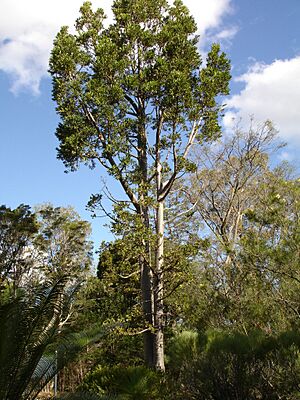Maranoa Gardens facts for kids
Quick facts for kids Maranoa Gardens |
|
|---|---|

Stenocarpus sinuatus planted in 1924
|
|
| Location | Balwyn, Victoria |
| Area | 2 hectares |
| Operated by | City of Boroondara |
| Vegetation | Featuring Australian native plants |
Maranoa Gardens is a unique public garden located in Balwyn, a suburb of Melbourne, Australia. What makes it special is that it's completely dedicated to showing off Australian native plants. It's like a living museum of Australia's amazing plant life!
The garden started in the early 1890s. A man named Mr. John Middleton Watson bought a piece of land, about 1.4 hectares, to create his own private garden. He filled it with many native trees and shrubs from Australia and New Zealand. He named his garden "Maranoa" after a river in Queensland. This name comes from native words meaning "flowing," "alive," or "running."
Contents
A Garden's Beginning
In 1922, the local council, which was then called the City of Camberwell, bought the garden. They decided to continue Mr. Watson's work. Over time, they carefully removed all the plants that were not native to Australia. This made Maranoa Gardens truly focused on Australian flora.
Opening to the Public
Maranoa Gardens officially opened its gates to the public in September 1926. Mr. F. Chapman became the Chairman of the Gardens' Consulting Committee. His strong interest, along with many other dedicated people, helped Maranoa Gardens become one of the largest displays of Australian plants in Victoria.
Many people helped the garden grow and develop. These included Ivo Hammet, who was a pioneer in growing Australian native plants. Mr. Arthur Swaby, a teacher and botanist, also played a key role. Charles French, who worked with the famous botanist Baron Ferdinand von Mueller, and Earnest Lord also contributed. The head gardener who worked there the longest, Mr. R. Bury (from 1937 to 1968), did a great job preserving and promoting the garden's plants.
Growing and Changing
In 1962, the garden nearly doubled in size! It expanded east into Beckett Park. A big part of this expansion was building a new rockery area. A special plant called the variegated Lophostemon was planted near the Beckett Park gates.
The garden has continued to develop over the years. In 1986, a new area was created to look like a temperate woodland and heathland. Then, in 1987, the rockery area was made even bigger and replanted. This section was designed for plants that are usually very tricky to grow in Melbourne's climate.
Special Plant Areas
Maranoa Gardens is one of the few public gardens in Victoria that focuses only on Australian plants. Many people think it's one of the best! Some of the oldest plants in the garden are still thriving. These include a Angophora costata, also known as Smooth-barked Apple, which was planted in 1923. There's also a Stenocarpus sinuatus, or Queensland Firewheel Tree, planted in 1924.
Other parts of the garden have been designed to look like specific plant communities found in Australia.
- Dry Forest: On the northern side, you can find a dry sclerophyll forest. Here, shrubs and smaller plants that do well in dry, shady spots are featured.
- Woodland and Heathland: The eastern side has a temperate woodland and heathland area, which was developed in 1986. The soil here was improved to help low-growing plants like Dampiera species and sprawling wattles (Acacia species) grow well.
The Rockery Garden
A special rockery area was first built in 1962 and then rebuilt in 1987–1988. This part of the garden shows off plants that are normally very hard to grow in Melbourne. The garden improved the drainage and added mulch made of crushed quartz. These changes created the perfect conditions for many plant species from Western Australia to grow and thrive.
Why Maranoa Gardens is Special
Maranoa Gardens is home to about 5,000 different plants, and most of them are clearly named. Because of its importance to Australian gardening history, the garden has been recognized by the National Trust of Australia. It's a wonderful place to learn about and enjoy Australia's amazing native plants!
Images for kids
-
Angophora costata at Maranoa Gardens, planted in 1923
-
Lophostemon confertus 'Variegatus' underplanted with Acacia cognata 'Limelight' at the main entrance








